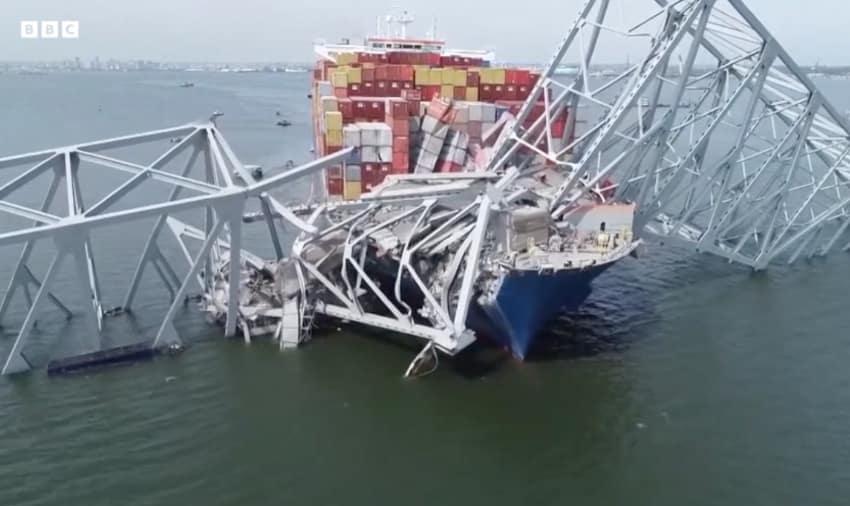Baltimore bridge collapse insured losses estimated up to $4bn

The insurance industry loss from the collapse of the Francis Scott Key Bridge in the US city of Baltimore after container ship Dali struck one of its support columns is estimated to be above the $1.5 billion of the Costa Concordia disaster, with as much as $4 billion in industry losses anticipated.
The reinsurance market is expected to take a sizeable chunk of the overall loss, while there is a chance some retrocessional arrangements see some exposure and as we reported yesterday, there is a chance of some losses leaking via quota share arrangements including reinsurance sidecars that contain a specialty lines allocation.
Yesterday, we reported that AM Best said the bridge collapse and ensuing complex claims environment could add to the increasing challenges of reinsurance availability.
In an analysis, Morningstar DBRS explained, “The collapse of the Francis Scott Key Bridge and the subsequent blockage of the Port of Baltimore will trigger a large number of insurance policies, including marine liability and hull, property, cargo, and business interruption.”
Estimating that, “Depending on the length of the blockage and the nature of the business interruption coverage for the Port of Baltimore, insured losses could total between $2 billion and $4 billion, surpassing the record insured losses of the Costa Concordia catastrophe.”
However, they noted that, “Despite the hefty insured losses, we expect they will remain manageable for the insurance industry as they involve a large and diversified pool of well capitalized insurers and reinsurers.”
“In our view, these losses will add to the woes of marine insurers who have been facing recent challenges due to the Houthi rebels’ attacks in the Red Sea,” explained Marcos Alvarez, Managing Director at Morningstar DBRS. “We also anticipate that the losses linked to the collapse of the Baltimore bridge will add upward pressure to the pricing of marine insurance coverages globally.”
While the damage to the bridge and its rebuilding will drive a significant insurance claim, some or all of which may be recovered under subrogation it is being suggested, and the marine loss of the ship also has the potential to be significant, it is the business interruption and port blockage related losses that are harder to estimate at this stage.
Morningstar DBRS noted that, “In 2023, the Port of Baltimore handled over $80 billion in cargo and more than 140,000 jobs depend on this natural harbour.”
Which led them to say, “Preliminary report assessments point to insured losses of several billions of dollars, possibly surpassing the catastrophe of Cost Concordia that incurred in a record marine insured loss of approximately $1.5 billion in 2012. If the Port of Baltimore has contracted business interruption insurance, we estimate that total insured losses will be in the $2 billion to $4 billion range.”
They added, “Subrogation among insurers is likely to follow as courts assign legal responsibility. This means that if courts determine that the ship owner is liable for the accident, then the insurers of the bridge and the port can recover insured losses from the liability insurers of the ship.”
Of course, business interruption claims will not just come from the port itself, but those that rely on it, including shipping and logistics companies, as well as companies that have relied on the port and bridge as a vital transportation link.
While Morningstar DBRS say that the insurance and reinsurance market has ample loss absorption capacity for such a loss as the one from this Baltimore bridge collapse, they do expect it to pressure the marine sector.
“We also anticipate that the losses linked to the collapse of the Baltimore bridge will add upward pressure to the pricing of marine insurance coverages globally,” they explained.
Equity analysts at TD Cowen said they believe the market loss will fall below $3 billion, but they also added it is likely to prove more costly to re/insurers than the Costa Concordia and is likely to “drive a material increase in marine (re)insurance pricing.”
For the insurance-linked securities (ILS) market, with minimal exposure to specialty lines such as marine, the sector would be watching most closely for any losses via quota shares and sidecars, or dedicated specialty ILS strategies of which there are a handful that could have marine reinsurance or retro exposure.
Or, perhaps at the extreme end of the loss scenarios, any business interruption impact via property policy claims although for that to happen it might require a much higher loss quantum to affect any ILS investments, aside from collateralized quota shares.
Step back a few years though and there have been marine events that have resulted in small impacts to the ILS market, including the Costa Concordia and the Tianjin, China port explosions in 2015, being two of them.
ILS losses were minor in the majority of cases, but those that had allocated to specialty lines took small shares, while some quota shares and sidecars experienced some attrition from each of these as well.
Also read: Baltimore bridge collapse could add to challenges in reinsurance availability: AM Best.






